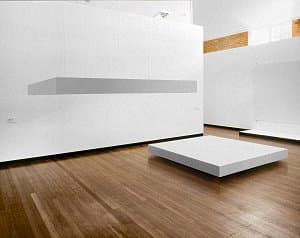

Robert Morris
Learn moreSlab (cloud) 1962 / 73
© Robert Morris. ARS/Copyright Agency Purchased 1979
More detail | PermalinkRobert Morris, one of the foremost American Minimalist artists, is best known for his geometric plywood sculptures. In December 1964, for his solo show at Green Gallery, New York, Morris exhibited a series of sculptures that were startlingly architectural in effect. Placed directly on the floor, across the corners of the space or suspended from the ceiling, these large, geometric, plywood forms were painted grey to have limited visual appeal and were, as Donald Judd commented at the time, ‘only barely present’.[1] Untitled (Corner beam), for example, was installed above a doorway and diagonally reached between two walls like a lintel, while Untitled (Corner piece) was set into the corner. These interconnected ‘units’ were, as Michael Desmond and Christine Dixon observe, ‘austere to the point of being aggressively abstract, and were plainly sculpture—architectural, yet distinct from architecture’.[2]
Slab (platform) had been exhibited in a group exhibition at Green Gallery in mid 1962, and again in Morris’ solo show in October–November 1963. Slab (cloud) was part of the 1964 show. Although the two works were not initially displayed as a pair, the artist saw them ‘existing in combination’ and now prefers for them to be shown together.[3] In volume and mass Slab (platform) and Slab (cloud) are, essentially, the same piece but the placement of each work impacts on perception. For the 1962 exhibition Morris had placed the square form directly on the floor so that it was seen from above, its legs causing the structure to appear slightly suspended. In 1964 the now-solid form hung much higher—and in conjunction with Untitled (Table), Untitled (Corner beam), Untitled (Floor beam), Untitled (Corner piece) and Untitled (Boiler)—to animate a section of the gallery.[4] By rethinking the object’s placement the artist emphasised how this affected the viewers’ experience of three-dimensional space, forcing them to negotiate the works and the space available to view the works. His use of mirrors in subsequent works allowed his cubes and other objects to seemingly merge into the floor or surroundings and become almost invisible.
Slab (platform) and Slab (cloud) were fabricated in metal in 1973. Morris also considered making a series of slabs:
The 1973 versions may be slightly different from the first ones built, not only in material (first ones were plywood) but dimensions. I think there was a few inches difference in thickness. There could have been a very long series of these slabs (maybe not as many as Brancusi’s Birds), each with a slightly different dimension, distance from the floor, shade of gray, etc. In fact I made several versions of each slab in plywood for various shows—it was easier to make these on the spot than ship them. But these have all been destroyed. The [National Gallery of Australia’s] are the only ones that now exist so far as I know: manifestations of a long but unrealised series.[5]
In 2016 the six components—along with another originally intended for installation in the 1964 show—were acquired and refabricated under the artist’s supervision for the Dia Art Foundation, Beacon, New York. Another version of Untitled (Corner piece) at the Guggenheim is refabricated in plywood each time it is exhibited. Together with Slab (platform) and Slab (cloud), these works mark one of the earliest and most important events in the history of Minimalism.
Lucina Ward
[1] Donald Judd, ‘Hartford,’ Arts Magazine 38, no 6, March 1964, and reprinted in Donald Judd: Complete writings 1959–1975, Press of the Novia Scotia College of Art and Design, Halifax, New York University Press, New York, 1975, p 117.
[2] Michael Desmond and Christine Dixon, 1968, National Gallery of Australia, Canberra, 1995, p 55.
[3] As the artist explained, ‘I am not as insistent on this as I am with [other works] … But it was at a certain point in time (exactly when I cannot remember) that the two works became a pair and I have wanted them shown that way ever since.’ Robert Morris, correspondence of 14 December 1985 with the National Gallery of Australia, NGA file 82/0639, f 78.
[4] For the various painted plywood works, see the Dia Art Foundation, New York, and the Panza Collection at Solomon R Guggenheim Museum, New York. ‘Robert Morris, Hanging slab (cloud)’, in Daniel Marzona and Uta Grosenick (ed), Minimal art, Taschen, Köln, 2004, p 78.
[5] Morris, NGA file 82/0639, f 78. Although another metal version of Slab (platform) is documented in Robert Morris, Tate Gallery, London, 1971, p 35—captioned: ‘Slab 1962 and 1968, painted steel, 96 x 96 x 8 [inches] (reconstruction: first version in plywood)’ and credited to Leo Castelli Gallery, New York—the artist commented in May 1986 that he recalled ‘making only two permanent slabs in metal: one hanging, one on the floor’. Moreover, Leo Castelli Gallery, advised that while records indicate the steel version of Slab, 1962/68 in the Tate catalogue did indeed exist, ‘unfortunately, we cannot tell you who has it now.’ (NGA file 82/0639, f 85 and 86).

